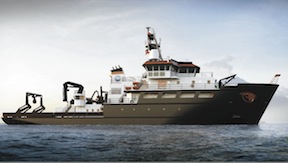The following is the text of a news release from Oregon State University:
(CORVALLIS, Ore.) — Oregon State University issued a request for proposals, or RFP, on Monday for a project to construct up to three advanced regional class research vessels to help replenish the aging United States academic fleet.
OSU will implement a two-stage “best value procurement process” for selecting a single shipyard in the United States to construct the vessels, which allows the university to evaluate proposals on qualitative factors in addition to cost factors. The deadline for submitting the first stage of proposals is Sept. 29 of this year.
In January 2013, the National Science Foundation selected OSU as the lead institution to finalize the design and coordinate the construction of a vessel — and possibly up to two more — a project considered crucial to modernizing the country’s marine science research capabilities.
These “regional class research vessels” are designed for studying coastal waters out to beyond the continental rise as part of the U.S. academic fleet that is available to all ocean scientists conducting federal- and state-funded research and educational programs.
The two-stage process will begin with technical proposals due Sept. 29, which will include but not be limited to descriptions of facilities, construction history, business history, financial capabilities, management practices, engineering and component subcontracting (including naming single-source vendors), and a schedule to construct the vessel, according to Demian Bailey, Oregon State’s former marine superintendent and a co-leader on the project.
The university will identify the shipyards best qualified for the project in the first stage and invite them to participate in the second stage of the RFP. Shipyards selected for this second stage will then submit an in-depth cost proposal due in early February. Final selection of a shipyard is anticipated to take place in April 2017. Delivery of the first ship, which will be operated by Oregon State University, is expected in fall of 2020.
Additional ships would likely be designated for the U.S. East Coast and the Gulf of Mexico, if funded by NSF with congressional appropriations and approval by the president. NSF would competitively select operators for those vessels, possibly in 2018.
Although similar in size, the new ships will differ greatly from R/V Oceanus, built in 1975 and operated by OSU, and its sister ships, R/V Endeavor, operated by the University of Rhode Island, and R/V Wecoma (retired), said Clare Reimers, a professor in the College of Earth, Ocean, and Atmospheric Sciences and project co-leader.
“This class of ships will enable researchers to work much more safely and efficiently at sea because of better handling and stability, more capacity for instrumentation and less noise,” Reimers said. “The design also has numerous ‘green’ features, including an optimized hull form, waste heat recovery, LED lighting, and variable speed power generation.”
The design of the ships was done by The Glosten Associates, a naval architecture firm based in Seattle.The research vessels will be 193 feet in length, with a range greater than 5,000 nautical miles. Cruising speed is 11 knots with a maximum speed of 12.5 knots, and there are 16 berths for scientists and 13 for crewmembers.

